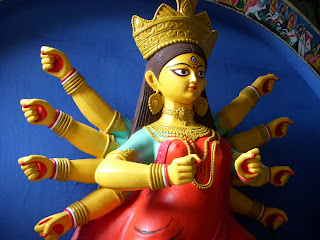When I reached one of the many pandals where scores of Durga idols were taking shape, the busy and skillful hands were shaping soft clay and fixing the beautifully sculptured feet to the Durga idol in preparation for her installation. The faces engrossed in the sacred act and the rings of smoke rising from bidis and cigarettes filled the claustrophobic space of these workshops.
The average studio is merely a ‘fenced-off ’ space, whose earthen floor is not even paved. The walls comprise a fencing of two wooden boards held together with rope and the roof is made of tin and matting. Electric lighting is minimal, and the bulbs are of low wattage. The artisans squat on the floor while at work, and the odd wooden stool or chair is meant for customers and visitors. Clay, the principal raw material, is brought by boat down the river Hooghly from Uluberia, a village near Calcutta. This clay is notable for its glutinous property, ideal for....

